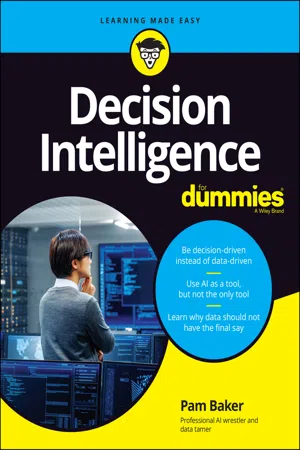
Decision Intelligence For Dummies
Pam Baker
- English
- ePUB (apto para móviles)
- Disponible en iOS y Android
Decision Intelligence For Dummies
Pam Baker
Información del libro
Learn to use, and not be used by, datato make more insightful decisions
The availability of data and various forms of AI unlock countless possibilities forbusiness decision makers.But what do you do when youfeelpressuredto cede yourposition in the decision-making process altogether?
Decision IntelligenceForDummies pumps the brakes onthe growing trend to take human beings out of the decision loop and walks you through the best way to make data-informed but human-driven decisions.The book shows you how toachieve maximum flexibilitybyusingeveryavailable resource, and not just raw data, to make the most insightful decisions possible.
In this timely book, you'll learn to:
- Make data a means to an end, rather thananend in itself, by expanding yourdecision-making inquiries
- Find a new path to solid decisionsthat includes, but isn't dominated, by quantitative data
- Measure the results of your newframeworkto prove its effectiveness and efficiencyand expand it to a whole team or company
Perfect forbusiness leaders in technology and finance, Decision IntelligenceForDummies is ideal for anyone who recognizes that data isnot the only powerful tool in your decision-making toolbox.This book shows you how to be guided, and not ruled, by the data.
Preguntas frecuentes
Información
Getting Started with Decision Intelligence
Short Takes on Decision Intelligence





The Tale of Two Decision Trails
Pointing out the way
- Anomaly detection, also known as outlier analysis, is a step in data mining (which can be aided by AI/ML or not) that finds deviations in the data from the norm, such as events (purchases on a charge or debit card in another country from where the cardholder is known to live or be, for example), and data point changes (attempts to change a social media account’s password via a device or browser that the true account holder is not known to use before, for example).
- Pattern recognition is the automated recognition of patterns discovered in the regularities in data. One example would be finding earlier signs of cancer in patient data than doctors and diagnosticians previously knew existed.
- Predictive modeling, also known as predictive analytics, analyzes historical patterns in the data using a mathematical process to predict future events or outcomes. One example would involve predicting when a machine part will need repair or replacement based upon its past usage compared to how long identical parts lasted under the same conditions.
- Recommendation engines analyze data to make recommendations or suggestions based on users’ past behaviors. Examples include analyzing your purchasing patterns in order to offer you a coupon for a grocery item you should be ready to buy again soon, or to recommend a movie based on movies you watched and rated earlier.
- Personalization systems use data analysis to customize a service, product, or automated communication. Examples include marketing emails sent to large numbers of customers, each personalized with the customer’s name and a custom discount offer for a favorite product or service.
- Classification and categorization systems automate the organization of vast amounts of data. Examples include sorting data files and data sets according to importance, topic, secrecy level, or other identifier; legal requirements governing the handling of specific data points (think of laws like General Data Protection Regulation (EU GDPR) which limit where personal data can be stored); and the nature of the data (such as structured machine data or unstructured Twitter posts). Data must be correctly classified and categorized for analytics or AI to work correctly. Automation is the ticket here because there’s so much data that it’s impossible to do it manually.
- Sentiment and behavioral analysis is contextual data mining to discover and analyze the subjective expressed responses (sentiments or feelings) about a brand, product, service, idea, political candidate, and so on in online conversations or customer channels (conversations and customer ratings found in texts, on websites and blogs, in voice recordings or streams during phone calls, and app rating systems. Did you rate that Door Dash driver’s service in the app? Yeah, that sort of thing!) Behavioral analysis can extend beyond sentiment analysis to include things like how long you spent reading a news article on your phone and how many times you return to a website, to what time of day an...
Índice
- Cover
- Title Page
- Copyright
- Table of Contents
- Introduction
- Part 1: Getting Started with Decision Intelligence
- Part 2: Reaching the Best Possible Decision
- Part 3: Establishing Reality Checks
- Part 4: Proposing a New Directive
- Part 5: The Part of Tens
- Index
- About the Book Author
- Connect with Dummies
- End User License Agreement
